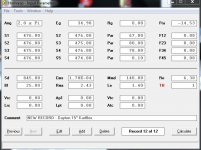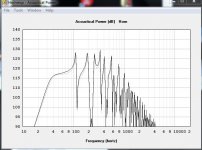Hi, I have been following this thread with great interest. Love when old ideas is taken to new heights. I've found this driver http://www.bluearan.co.uk/sales/faital_pro/15FH510_datasheet_8.pdf and it seems to fit the project perfect. High BL 21, x-max 9,25mm, high sensitivity 98db. For 157 euro = 175 $ it is a fair deal in my opinion.
My problem is that I can't simulate in akabak only hornresp. And the newest iterations is simulated in akabak. I would like a frequency response from 35 to 500hz. Hope some can help point out the right box model for this driver and suggestions for aperture.
A big thanx should go out to Mr. Matthew Morgan for taken the time to do all this work and infuse others including me, with great inspiration, thanx.
View attachment 502398
Regards Sebastian
Hello Sebastian !
I am glad you are enjoying this thread 🙂
That driver looks like a good driver (as long as you are ok with the price after that Pound/Euro currency exchange) ...
The Faital Pro would likely work in a Karlflex with the cabinet width scaled up ...The usable bandwidth would easily reach out to 500hz, and could likely reach 2khz just like this prototype with 12" driver does (since the front of the driver's cone does not need to be obscured now, and the driver is not recessed very far into the cabinet thanks to the slant of the baffle🙂) ......
Tonal balance should be acceptable especially with DJK's estimate of 96db 1w/1m efficiency ..... In my opinion the QES/QTS is slightly low and VAS is a bit high but should still work well enough ...
Take a look at that reply that i just left for Freddi, it goes into more details about what is ideal in driver parameters.
By the way , other options for that particular driver could be a Tapped Horn but that wont get you up to 500hz , then there is a Front Loaded Horn or a Back Loaded horn but those are 4th order boxes and would likely need to be large to get you down to 35hz with authority ..... The Karlflex (and also the ML-Transflex cabs and tapped horns/tapped pipes) are 6th order series tuned designs which if executed correctly can be made more compact than 4th order horns (with competitive bass extension).
Last edited:
Heck yes
DJK ,
That is definitely a great value!!
Based upon the Eminence response chart it looks like this driver will be good out to about 1.3k-ish which is fine since 15s tend to lose dispersion and get beamy above that frequency anyhow ..🙂
Eminence :: Eminence Kappa Pro 15 LF C 15" 600W 4 Ohm Loudspeaker Driver Twin Pack 276.34
7.9mm, two for £276.34 (£138.17 each in pairs)
DJK ,
That is definitely a great value!!
Based upon the Eminence response chart it looks like this driver will be good out to about 1.3k-ish which is fine since 15s tend to lose dispersion and get beamy above that frequency anyhow ..🙂
Last edited:
That was nice
I appreciate this Sebastian ! Thank you!
I think it would be great to see people trying more unusual combinations and unorthodox ideas or just strange new amalgamations of old concepts because useful things can occasionally come out of such experimentation 🙂
Sometimes there is treasure to be found if you are willing to venture off of the beaten path!
A big thanx should go out to Mr. Matthew Morgan for taken the time to do all this work and infuse others including me, with great inspiration, thanx.
Regards Sebastian
I appreciate this Sebastian ! Thank you!
I think it would be great to see people trying more unusual combinations and unorthodox ideas or just strange new amalgamations of old concepts because useful things can occasionally come out of such experimentation 🙂
Sometimes there is treasure to be found if you are willing to venture off of the beaten path!
I appreciate this Sebastian ! Thank you!
I think it would be great to see people trying more unusual combinations and unorthodox ideas or just strange new amalgamations of old concepts because useful things can occasionally come out of such experimentation 🙂
Sometimes there is treasure to be found if you are willing to venture off of the beaten path!
You are absolutly right and you are a perfect example of that🙂 Unfortunately I don't posses the in depht knowkledge about this particular design like you. Therefor I have to stand on yours an others shoulders, pun intended😀
Tapped horns and front loaded horns, been there done that
 . In fact my garage horns is why I am studying this thread. In my honest humble opinion, with 110dB/w, they have the most realistic reproduction with startling dynamics and transient response, I have ever heard. NO box speakers even comes close. But they ARE a large 3-way system and WAF is small.
. In fact my garage horns is why I am studying this thread. In my honest humble opinion, with 110dB/w, they have the most realistic reproduction with startling dynamics and transient response, I have ever heard. NO box speakers even comes close. But they ARE a large 3-way system and WAF is small. When people hear them, they sit with a big grin on there face, AFTER they have picked up the jaw from the floor😀 And then the question usually goes "how can I have that sound (approximately) in a smaller package". So that it is what i'm trying to do. I want a bassbin that have some of the dynamic, slamm and sensitivity like true horns. A hornloaded driver will come in at ca. 500hz to cover the rest. Foot print is still quite large but without the true horn subs it is still much more manegeble and it is a 2-way = more simple and less electronic.
Here is a picture of my garage setup. I call it Horns by Night 🙂

Cheers Sebastian
Very nice
That is a great looking set of horns Sebastian! Good job on that!
Jaw dropping realism, dynamics and transient response you say? Yep, that is totally believable because i know about how properly executed midrange horns can have a majestic presentation such as you described ...
A true 110db @ 1w/1m is an admirable level of efficiency🙂 The shorter wavelengths of the midrange allow us to achieve that kind of extreme performance using horns that are not outlandishly large, but unfortunately the long wavelengths of the bass and sub-bass range are a whole other story as i am sure you already know "WAF" (as you say) becomes an issue with monstrously large cabinets, hehehe😉 ........ So in order to have a smaller bass cabinet some compromises are made with the Karlflex in the efficiency department (especially if you want extension down to the mid 30s), however everything else that you desire such as extension, dynamics, impact, detail and bandwidth will all be there in abundance to enjoy as long as the right driver is used.
From what you have said it seems like you plan on Bi-amping the system right? So in this case you will just need to have the signal chain gains a little higher on the bass channel (or the gains on the mid channel lower, either way could work) in order to get the system to sound balanced, but i am sure you know all of this already too, i just wanted to make sure you know that these Karlflex cabs in singles wont approach the level of efficiency that your midrange horns have unless used in multiples but then you will experience WAF problems again 😀
I am working on putting together a short list of 15" drivers for use in a Karlflex along with their "pros and cons" , once again (just like with 12s) it is difficult to find the perfect driver but we can get close enough without spending too much...
That is a great looking set of horns Sebastian! Good job on that!
Jaw dropping realism, dynamics and transient response you say? Yep, that is totally believable because i know about how properly executed midrange horns can have a majestic presentation such as you described ...
A true 110db @ 1w/1m is an admirable level of efficiency🙂 The shorter wavelengths of the midrange allow us to achieve that kind of extreme performance using horns that are not outlandishly large, but unfortunately the long wavelengths of the bass and sub-bass range are a whole other story as i am sure you already know "WAF" (as you say) becomes an issue with monstrously large cabinets, hehehe😉 ........ So in order to have a smaller bass cabinet some compromises are made with the Karlflex in the efficiency department (especially if you want extension down to the mid 30s), however everything else that you desire such as extension, dynamics, impact, detail and bandwidth will all be there in abundance to enjoy as long as the right driver is used.

From what you have said it seems like you plan on Bi-amping the system right? So in this case you will just need to have the signal chain gains a little higher on the bass channel (or the gains on the mid channel lower, either way could work) in order to get the system to sound balanced, but i am sure you know all of this already too, i just wanted to make sure you know that these Karlflex cabs in singles wont approach the level of efficiency that your midrange horns have unless used in multiples but then you will experience WAF problems again 😀
I am working on putting together a short list of 15" drivers for use in a Karlflex along with their "pros and cons" , once again (just like with 12s) it is difficult to find the perfect driver but we can get close enough without spending too much...
Last edited:
Thanx for your appreciation Matthew. The round horn is made of normal paper for a copy machine and woodglue. My hifi buddies thougth I was joking when I told them and said that japanese origami had been taken another level 😛
Yes, I know about the lesser sesitivity in Karlflex. 110dB/w is only for horns or big line arrays. But I think around 100 dB/w will be achievable, with the right driver. This is still about 10dB more than a normal box speaker and like getting 10 X amplification without power compression😉 And the paper horn can be driven by a quality 3" or 4" broadband driver and easily get 100dB/w and will be much cheaper than the JBL compression driver I'm using. With minidsp and 2 X 100 watt decent amps you are flying beautiful🙂 A pretty cheap high performance system I my opinion. Well I have to build it first then I'll know🙄
Cheers Sebastian
Yes, I know about the lesser sesitivity in Karlflex. 110dB/w is only for horns or big line arrays. But I think around 100 dB/w will be achievable, with the right driver. This is still about 10dB more than a normal box speaker and like getting 10 X amplification without power compression😉 And the paper horn can be driven by a quality 3" or 4" broadband driver and easily get 100dB/w and will be much cheaper than the JBL compression driver I'm using. With minidsp and 2 X 100 watt decent amps you are flying beautiful🙂 A pretty cheap high performance system I my opinion. Well I have to build it first then I'll know🙄
Cheers Sebastian
Here is the setup I make the mold on.
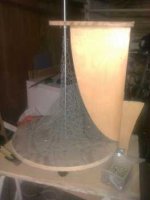
Then I put concrete/plaster on.
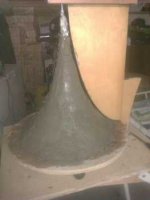
A horn of this size take some work to do 6 to 8 hours and a trip to a chiropractor afterwards, because of the repeated movements😉.
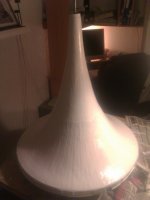
Horn in mount stand with JBL driver.
Cheers Sebastian
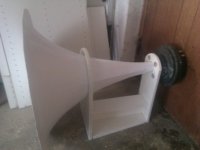
Here on top of midbass horn with 15" driver covering 90-450hz.
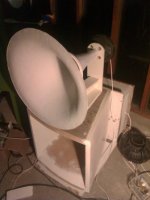

Then I put concrete/plaster on.

A horn of this size take some work to do 6 to 8 hours and a trip to a chiropractor afterwards, because of the repeated movements😉.

Horn in mount stand with JBL driver.
Cheers Sebastian

Here on top of midbass horn with 15" driver covering 90-450hz.

Beta 12a does sound interesting and has a healthy 4.8mm xmax figure - since I have Kappa12a laying around, I would be quite happy with strong output to 60Hz and corner right below that figure - with some input I might get one built by TheJessman - if he has time
I might pick up a PA310 - would there be one design compatible with both PA310 and Kappa12a and not compromise?
I might pick up a PA310 - would there be one design compatible with both PA310 and Kappa12a and not compromise?
An externally hosted image should be here but it was not working when we last tested it.
Origorns
Sebastian ,
That is some remarkable ingenuity on your part..
Cannot beat the affordability of some printer paper and wood glue right? 😉
I imagine that with enough layers of paper and wood glue it could be durable as well.
Sebastian ,
That is some remarkable ingenuity on your part..
Cannot beat the affordability of some printer paper and wood glue right? 😉
I imagine that with enough layers of paper and wood glue it could be durable as well.
Last edited:
Sebastian ,
That is some remarkable ingenuity on your part..
Cannot beat the affordability of some printer paper and wood glue right? 😉
I imagine that with enough layers of paper and wood glue it could be durable as well.
Thanx, but can't take full credit for ingenuity🙄 I boroughed the idea from this guy: inlowsound.com. He is a real master, check out his site, a lot of cool stuff.
Yes, paper and glue, with enough layers it behaves like wood, soundwise, with good internally dampning. Much more relaxed and natural, compared to steel/iron, stone or plastic, I believe. And yes it is quite durable. Think it can last for years.
And once you have build the mould you can produce as many horns you want. I found an easier way to make them, without compromising sound quality. I took sawdust and torn wet paper, mixed it with woodglue, wallpaperglue and a little bit of plaster and blended it to a paper mache pulp. Then I rolled it like pizza doe and clamped it on the mould. It only took 1.5 hour to make a horn, though not as beautiful to behold it sounds and measures like the paper horn.
Regards Sebastian
Drivers and sims
Hi Freddi ,
Either Driver can be made to work (Beta or Kappa) they just have different curves on the bottom end with the Beta having more of a hump between 65hz to 150hz looking sort of like a classic Karlson response, and the Kappa on the other hand has more of a steady rising response .....
Lately using Hornresp I have found a quick and dirty way for estimating what internal volume will be required for a given driver (in a Karlflex) in order to get the desired curve, extension and output on the bottom end.... It is of course not entirely accurate (especially the case over 200hz-ish) it just gives you an idea about whether or not the model is overdamped or underdamped (assuming that the front to rear chamber ratio will be similar to what i have been using in my Akabak models)...
I will be drawing up a new sketches here soon, and the Karlflex cabinet that i plan to use for the Pa310 will have a higher tune (by about 5 hertz) and will also have the option to lean the top of the baffle back by another few inches if a person wants to achieve a higher tune while additionally benefiting from the larger front chamber that results from the baffle shift, and i think this will suit your design goals Freddi 😀 ..... The two options for apertures will be a K-slot with narrow gap or a just a simple terminus (mouth) with no slot above the driver (either way seems to work well, the latter just tunes lower and favors deeper bass at the sacrifice of the mids by only a small amount as long as the cone is not obscured, so for your design goals you would want to go with the slot of course) ..... A wider slot (above driver) could possibly be a third option for drivers with lower efficiency in the upper midrange such as the MCM 55-2992 ....
Now that i feel like i have a pretty good idea of what is going on with the different aperture shapes i next plan on blocking off the parasitic section which not only changes the configuration into a simple Karflex but also reduces internal volume considerably (down to about 60 liters), this is necessary to observe the effects..... I am confident that 60 liters would be fine for a 50hz tune but may or may not be undersized for a 40hz tuned Karflex with Pa310, and this experiment will help me determine just how closely the internal air-space requirements reflect what the simulations are suggesting ..
..
Beta 12a does sound interesting and has a healthy 4.8mm xmax figure - since I have Kappa12a laying around, I would be quite happy with strong output to 60Hz and corner right below that figure - with some input I might get one built by TheJessman - if he has time
I might pick up a PA310 - would there be one design compatible with both PA310 and Kappa12a and not compromise?
Hi Freddi ,
Either Driver can be made to work (Beta or Kappa) they just have different curves on the bottom end with the Beta having more of a hump between 65hz to 150hz looking sort of like a classic Karlson response, and the Kappa on the other hand has more of a steady rising response .....
Lately using Hornresp I have found a quick and dirty way for estimating what internal volume will be required for a given driver (in a Karlflex) in order to get the desired curve, extension and output on the bottom end.... It is of course not entirely accurate (especially the case over 200hz-ish) it just gives you an idea about whether or not the model is overdamped or underdamped (assuming that the front to rear chamber ratio will be similar to what i have been using in my Akabak models)...
I will be drawing up a new sketches here soon, and the Karlflex cabinet that i plan to use for the Pa310 will have a higher tune (by about 5 hertz) and will also have the option to lean the top of the baffle back by another few inches if a person wants to achieve a higher tune while additionally benefiting from the larger front chamber that results from the baffle shift, and i think this will suit your design goals Freddi 😀 ..... The two options for apertures will be a K-slot with narrow gap or a just a simple terminus (mouth) with no slot above the driver (either way seems to work well, the latter just tunes lower and favors deeper bass at the sacrifice of the mids by only a small amount as long as the cone is not obscured, so for your design goals you would want to go with the slot of course) ..... A wider slot (above driver) could possibly be a third option for drivers with lower efficiency in the upper midrange such as the MCM 55-2992 ....
Now that i feel like i have a pretty good idea of what is going on with the different aperture shapes i next plan on blocking off the parasitic section which not only changes the configuration into a simple Karflex but also reduces internal volume considerably (down to about 60 liters), this is necessary to observe the effects..... I am confident that 60 liters would be fine for a 50hz tune but may or may not be undersized for a 40hz tuned Karflex with Pa310, and this experiment will help me determine just how closely the internal air-space requirements reflect what the simulations are suggesting
 ..
..
Last edited:
Hi Matthew. I found these two 15" drivers. Price is the same about 150$ in Denmark.
Xmax for both is 5mm.
The Box 15" specs

The Box 15" FR
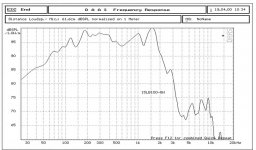
Dayton Audio PA380-8 15" specs
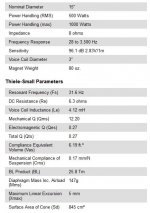
FR

As you see The Box has lower VAS, as you recomment, but it seems that Dayton rules in the bass, with higher sensitivity and higher QMS.
I would like to use them in a Karlflex from say 35hz and up to 500hz. What say you 🙂
Cheers
Xmax for both is 5mm.
The Box 15" specs

The Box 15" FR

Dayton Audio PA380-8 15" specs

FR

As you see The Box has lower VAS, as you recomment, but it seems that Dayton rules in the bass, with higher sensitivity and higher QMS.
I would like to use them in a Karlflex from say 35hz and up to 500hz. What say you 🙂
Cheers
Quick and dirty initial sim method
Sebastian,
Manufacturer graphs are funny things in regards to making driver choices ... My personal philosophy is not to concern myself with (I just disregard) what the published graph looks like below 100hz, because the true bottom end response will be determined by the interaction between driver parameters and your cabinet design....... ...................................................... However those graphs that the manufacturers provide are still very useful for getting an idea of what the driver is capable of in the midrange and upper midrange frequencies, and where the intrinsic dips and peaks in the driver's mid response will likely be (some of which you can use to your advantage) etc ....
To get an idea of what the bass response will actually be like you will need to plug the parameters into a good simulator like Hornresp ..... If you make something like a 1/3rd-offset-driver tapped pipe (transflex) in HR's "TH" mode with the other side of the cone placed at the very end of the pipe (slider "L45" at 0.10) , then make the pipe long enough to tune it to 37hz , and add enough cross sectional area in each segment (make them all match in this case) to give you 100 liters internal airspace, you can then plug various drivers into that basic model and it will give you a rough estimate of what your bottom end contour and extension might be in a Karlflex, this is the quick and dirty way😛 , and even though it doesn't take into account the mass loading feature and aperture/front-chamber features of the Karlflex it still works well enough as a method for figuring out what drivers might make a worthy candidate ...
Try it so you can see what i am talking about, and you will find out that most 15" drivers want a bigger box in order to get reasonably flat down to 35hz but i have found a few that will work in a 100 liter cab mainly because of low VAS figures and strong motors .... I have been working on a list of 15s, i will post it tonight or tomorrow
Hi Matthew. I found these two 15" drivers. Price is the same about 150$ in Denmark.
Xmax for both is 5mm.
As you see The Box has lower VAS, as you recomment, but it seems that Dayton rules in the bass, with higher sensitivity and higher QMS.
I would like to use them in a Karlflex from say 35hz and up to 500hz. What say you 🙂
Cheers
Sebastian,
Manufacturer graphs are funny things in regards to making driver choices ... My personal philosophy is not to concern myself with (I just disregard) what the published graph looks like below 100hz, because the true bottom end response will be determined by the interaction between driver parameters and your cabinet design....... ...................................................... However those graphs that the manufacturers provide are still very useful for getting an idea of what the driver is capable of in the midrange and upper midrange frequencies, and where the intrinsic dips and peaks in the driver's mid response will likely be (some of which you can use to your advantage) etc ....
To get an idea of what the bass response will actually be like you will need to plug the parameters into a good simulator like Hornresp ..... If you make something like a 1/3rd-offset-driver tapped pipe (transflex) in HR's "TH" mode with the other side of the cone placed at the very end of the pipe (slider "L45" at 0.10) , then make the pipe long enough to tune it to 37hz , and add enough cross sectional area in each segment (make them all match in this case) to give you 100 liters internal airspace, you can then plug various drivers into that basic model and it will give you a rough estimate of what your bottom end contour and extension might be in a Karlflex, this is the quick and dirty way😛 , and even though it doesn't take into account the mass loading feature and aperture/front-chamber features of the Karlflex it still works well enough as a method for figuring out what drivers might make a worthy candidate ...
Try it so you can see what i am talking about, and you will find out that most 15" drivers want a bigger box in order to get reasonably flat down to 35hz but i have found a few that will work in a 100 liter cab mainly because of low VAS figures and strong motors .... I have been working on a list of 15s, i will post it tonight or tomorrow
Good stuff!
Excellent! , you have the right idea, now adjust "L12" (driver offset) in the Loudspeaker Wizard to even out that nasty ripple around 120hz and when you get it adjusted correctly you should have usefully smooth response up to around 200hz .....
NOTE: Be sure to double the published Le figure ....... Also be sure to keep an eye on cone movement, then adjust the voltage (drive) until that peak in excursion above FB matches the XMAX rating of the driver, then make a note of the SPL in halfspace at that voltage..
A few good drivers to try out would be:
PRV 15W1600
Eminence Kappalite 3015LF 4 0HM version
B&C 15CL76
AudioPile AP-1526-8 (VAS=119L ,QTS=.36 , QMS=3.6, FS=40 , SD=850 , Le=1 , XMAX=8mm )
Dayton PA385S-8 FOR BASS RANGE ONLY
Eminence Lab15-4 FOR BASS RANGE ONLY
Thanx for the tips Matthew. I simulated as you said (I think😱) and got a box with these data
Black is the box and grey Dayton, not much difference, but a little nod to the box. But I will make the box a little bit bigger to get the most of it.
Cheers
Excellent! , you have the right idea, now adjust "L12" (driver offset) in the Loudspeaker Wizard to even out that nasty ripple around 120hz and when you get it adjusted correctly you should have usefully smooth response up to around 200hz .....
NOTE: Be sure to double the published Le figure ....... Also be sure to keep an eye on cone movement, then adjust the voltage (drive) until that peak in excursion above FB matches the XMAX rating of the driver, then make a note of the SPL in halfspace at that voltage..
A few good drivers to try out would be:
PRV 15W1600
Eminence Kappalite 3015LF 4 0HM version
B&C 15CL76
AudioPile AP-1526-8 (VAS=119L ,QTS=.36 , QMS=3.6, FS=40 , SD=850 , Le=1 , XMAX=8mm )
Dayton PA385S-8 FOR BASS RANGE ONLY
Eminence Lab15-4 FOR BASS RANGE ONLY
Last edited:
Hi Matthew, I simulated a bit more. None of the recommended drivers could perform better, and they will be much more exspensive. Remember I am in Europe, higher taxes and such + shipping cost 😡.
Here is the data
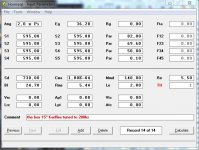
The cabinet will be 120 liter.
FR
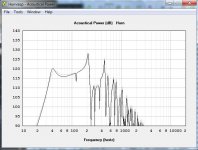
Black is the box and grey Dayton. Not much difference again. And I will have digital x-over with EQ to taste so no problems in smoothing response.
This was a lesson in Hornresp, thanx 😉. Now I just need to learn Akabak to simulate to full 500 hz 😕
Cheers
Here is the data

The cabinet will be 120 liter.
FR

Black is the box and grey Dayton. Not much difference again. And I will have digital x-over with EQ to taste so no problems in smoothing response.
This was a lesson in Hornresp, thanx 😉. Now I just need to learn Akabak to simulate to full 500 hz 😕
Cheers
troubleshooting
Sebastian ,
Yes , Akabak is needed to sim out to 500hz (and to also include all of the Kalrflex features).. Loading up some scripts that someone else made would help you get the hang of it quickly and soon you will be editing your own scripts 🙂...
Regarding the above sims It looks like something has gone amiss with the HR inputs that you are using ............ Hmmmmm , i will take a closer look
, i will take a closer look 
Forgive me if i sound critical or persnickety here, this is just me looking over the details so we can get to the bottom of this and make solid choices ...
Be sure to take the very high Le figure into account for that Dayton Pa380 driver and double it (which gives me 8.2 millihenry) ... I was able to drive it at 32v to reach 5mm of excursion and the curve looks different than what you posted ...... I get 114db @ 35hz , 115.8 @40hz , 116.5@ 60.62hz , 118.8@94.4hz ......
Your curve looks very saddle shaped (underdamped) which makes me wonder if your Le figure is set low or if FB is tuned high in the model ....
Very high Le figures can take away from performance by making a driver behave somewhat like it has less motor strength and that high inductance also tends to cause an early upper response roll off which limits your bandwidth, and when combined with the Pa380s very low QTS and low FS i have to say that when taking everything into consideration i really cannot recommend that driver because i can't guarantee it will produce satisfying results.... If you will notice in Dayton's graph the PA-380 only produces 90db@1w/1m @ 500hz which is not very efficient , the loading of the front chamber may add a little bit of output in that range but not nearly enough to make it as loud as that 15LB100-8 in the same cabinet .....
Check your HR model's impedance curve for the impedance minimum, that is your FB or "box tuning" , looking at the path length of your sim it looks like your FB is higher than 37hz ... Is 35hz output still your goal? Or are you shooting for 40hz now? Let me know.... 40hz would actually make things easier , my personal target is 40hz to 42hz in my Pa310 cab ..... Have you analyzed the music that you listen to in order to see if there is anything going on below 40hz? A lot of music has nothing below 40 but it depends on what you listen to...
That "The Box" brand 15LB100-8W looks like a much better driver with it's lower voicecoil inductance, strong motor, Low VAS, higher FS, stronger output at 500hz , it will sound louder in the midrange and will have better cone control in the bass range ........ But i should mention that there is one thing that i thought was wonky about the figures which concerned me, it is the SD figure you used in the HR sim, for that driver it should be up around 850sq cm assuming the driver is not smaller than your average Pro 15" with relatively narrow accordion style surround (i am looking at the picture on the Thomann website and the width of the surround looks standard to me)... I adjusted the SD figure in my HR model but the important factors like FS, Vas, Qts all still work out close enough to what is published...
Here are the quick & dirty sims i ended up with in HR:
Grey line is the PA380, Black line is the 15LB100-8w .... The Dayton starts falling behind the 15LB100 at around 150hz , then if you look closely at that mess between 210hz and 450hz you can see that the Dayton falls behind throughout that range as well, this is due to the high inductance value .... Of course the response is not truly going to look that volatile, this model is only really remotely accurate up to around 200hz and isn't taking into account the effects of the mass loading, front chamber, the Freddi-Mod absorber cavity, or the effects of stuffing/lining ...
Hi Matthew, I simulated a bit more. None of the recommended drivers could perform better, and they will be much more exspensive. Remember I am in Europe, higher taxes and such + shipping cost 😡.
Black is the box and grey Dayton. Not much difference again. And I will have digital x-over with EQ to taste so no problems in smoothing response.
This was a lesson in Hornresp, thanx 😉. Now I just need to learn Akabak to simulate to full 500 hz 😕
Cheers
Sebastian ,
Yes , Akabak is needed to sim out to 500hz (and to also include all of the Kalrflex features).. Loading up some scripts that someone else made would help you get the hang of it quickly and soon you will be editing your own scripts 🙂...
Regarding the above sims It looks like something has gone amiss with the HR inputs that you are using ............ Hmmmmm
 , i will take a closer look
, i will take a closer look 
Forgive me if i sound critical or persnickety here, this is just me looking over the details so we can get to the bottom of this and make solid choices ...
Be sure to take the very high Le figure into account for that Dayton Pa380 driver and double it (which gives me 8.2 millihenry) ... I was able to drive it at 32v to reach 5mm of excursion and the curve looks different than what you posted ...... I get 114db @ 35hz , 115.8 @40hz , 116.5@ 60.62hz , 118.8@94.4hz ......
Your curve looks very saddle shaped (underdamped) which makes me wonder if your Le figure is set low or if FB is tuned high in the model ....
Very high Le figures can take away from performance by making a driver behave somewhat like it has less motor strength and that high inductance also tends to cause an early upper response roll off which limits your bandwidth, and when combined with the Pa380s very low QTS and low FS i have to say that when taking everything into consideration i really cannot recommend that driver because i can't guarantee it will produce satisfying results.... If you will notice in Dayton's graph the PA-380 only produces 90db@1w/1m @ 500hz which is not very efficient , the loading of the front chamber may add a little bit of output in that range but not nearly enough to make it as loud as that 15LB100-8 in the same cabinet .....
Check your HR model's impedance curve for the impedance minimum, that is your FB or "box tuning" , looking at the path length of your sim it looks like your FB is higher than 37hz ... Is 35hz output still your goal? Or are you shooting for 40hz now? Let me know.... 40hz would actually make things easier , my personal target is 40hz to 42hz in my Pa310 cab ..... Have you analyzed the music that you listen to in order to see if there is anything going on below 40hz? A lot of music has nothing below 40 but it depends on what you listen to...
That "The Box" brand 15LB100-8W looks like a much better driver with it's lower voicecoil inductance, strong motor, Low VAS, higher FS, stronger output at 500hz , it will sound louder in the midrange and will have better cone control in the bass range ........ But i should mention that there is one thing that i thought was wonky about the figures which concerned me, it is the SD figure you used in the HR sim, for that driver it should be up around 850sq cm assuming the driver is not smaller than your average Pro 15" with relatively narrow accordion style surround (i am looking at the picture on the Thomann website and the width of the surround looks standard to me)... I adjusted the SD figure in my HR model but the important factors like FS, Vas, Qts all still work out close enough to what is published...
Here are the quick & dirty sims i ended up with in HR:
An externally hosted image should be here but it was not working when we last tested it.
Grey line is the PA380, Black line is the 15LB100-8w .... The Dayton starts falling behind the 15LB100 at around 150hz , then if you look closely at that mess between 210hz and 450hz you can see that the Dayton falls behind throughout that range as well, this is due to the high inductance value .... Of course the response is not truly going to look that volatile, this model is only really remotely accurate up to around 200hz and isn't taking into account the effects of the mass loading, front chamber, the Freddi-Mod absorber cavity, or the effects of stuffing/lining ...
An externally hosted image should be here but it was not working when we last tested it.
Last edited:
Forgive me if i sound critical or persnickety
Accuracy can never be bad in this case, so I won’t hold it against you 😉
Why is it you use 2 x Le? Is the driver behaving differently in this design, so you can assume this?
I calculated the SD in hornresp and got 890 cm2. Don’t know about the 750, my bad I guess.
Funny you mention music below 40 hz. First I listen to all sort of music. Form Mozart to Metallica so to speak. Also a lot of good recorded acoustic music, so very diverse.
The other day I low-passed my subs under 40 hz to flat 20 hz with 48 db/oct. filter and muted all but the subs. And what you hear is a bit of unrecognisable rumble. There is not much going on down there, on most recordings, but I think it contributes to the soundstage and overall feel of the music. But I guess if it makes the Karlflex suffer to go to much below 40, it makes no sense in doing so. There is still output below 40 just not full amplitude and I think it will suffice.
I will look more into hornresp later, when time will let me.
Thanx for taken the time to walk me through this process 🙂
Accuracy can never be bad in this case, so I won’t hold it against you 😉
Why is it you use 2 x Le? Is the driver behaving differently in this design, so you can assume this?
I calculated the SD in hornresp and got 890 cm2. Don’t know about the 750, my bad I guess.
Funny you mention music below 40 hz. First I listen to all sort of music. Form Mozart to Metallica so to speak. Also a lot of good recorded acoustic music, so very diverse.
The other day I low-passed my subs under 40 hz to flat 20 hz with 48 db/oct. filter and muted all but the subs. And what you hear is a bit of unrecognisable rumble. There is not much going on down there, on most recordings, but I think it contributes to the soundstage and overall feel of the music. But I guess if it makes the Karlflex suffer to go to much below 40, it makes no sense in doing so. There is still output below 40 just not full amplitude and I think it will suffice.
I will look more into hornresp later, when time will let me.
Thanx for taken the time to walk me through this process 🙂
Hi Y'all,
I don't know if you are aware of the new "Large Voice Coil" feature in the Hornresp Loudspeaker Wizard. When you open up the Wizard in the Schematic Diagram at the bottom left hand below the schematic window is now a button "Large Voice Coil"; check this, and move to the Acoustical Power window, now you should be seeing the SPL curve in grey (normal driver/voice coil) and in red (large voice coil). This feature was added by David McBean based on the suggestions and work of "just a guy", also known as the JAG Fix or Tweak.
Regards,
I don't know if you are aware of the new "Large Voice Coil" feature in the Hornresp Loudspeaker Wizard. When you open up the Wizard in the Schematic Diagram at the bottom left hand below the schematic window is now a button "Large Voice Coil"; check this, and move to the Acoustical Power window, now you should be seeing the SPL curve in grey (normal driver/voice coil) and in red (large voice coil). This feature was added by David McBean based on the suggestions and work of "just a guy", also known as the JAG Fix or Tweak.
Regards,
- Home
- Loudspeakers
- Subwoofers
- New sub design? Constricted Transflex, simple build (series tuned 6th order)
